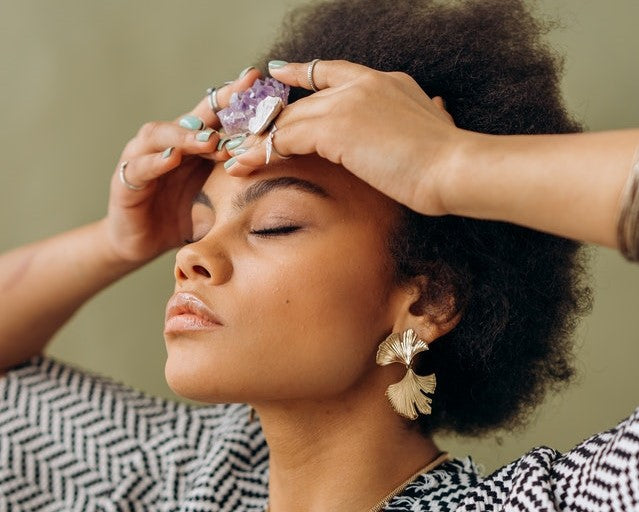Chakras are the talk of the town within the spiritual community, and for good reason. But you don’t need to be a reiki master or yogi to understand chakras, especially if you have your heart set on spiritual growth. If you’re well-versed in the esoteric world or take the practice of yoga seriously, you might have heard about blocked chakras and the necessity of unblocking them but exactly what does this all mean?
What Are Chakras
Before we dive into the practice of unblocking chakras, you might want a little context. The origins of chakras are traced back to ancient Indian traditions and represent the energetic center of the body. The word “chakra” is Sanskrit and translates to “disk” or “wheel.” In the western world, we’ve adopted seven of these energetic chakra points that can be blocked — meaning these areas are under or overstimulated — or unblocked — meaning these areas are moderate and balanced. Each disk of energy represents a manifestation of life.
Why Are Chakras Important
From a spiritual perspective, harmony and moderation are vastly important. Sustaining peace often means keeping your energy balanced. If your chakras are blocked, this can hinder your spiritual growth and manifest in issues in your daily life. There are dualities when chakras are blocked, meaning you may feel an excess or severe lack of something depending on the chakra. For example, if your throat chakra is blocked, you might either have persistent run-ins with confrontation or have a hard time finding the right words to say at all. When your chakras are unblocked, you’re able to speak smoothly and lead with an open mind.
You can balance your chakras by working through the areas they represent. If you feel like your heart chakra is blocked, indulging in self love by writing yourself affirmations or showing affection to your partner may be good ways to restore balance. Suffice to say, keeping things in order all the time is impossible and unfair to expect of the average human. Even the most spiritually aligned people may struggle with being peaceful.
However, it’s worth trying restore balance when and where you can, and the practice of chakra is an advantageous way of doing so.
What Does Each Chakra Represent
Root Chakra (Muladhara)
Where it’s located: Base of the spine near the genital area.
Area it represents: The root chakra represents the primitive parts of ourselves, including our natural survival, security, and self-sufficiency. When this chakra is blocked, we may feel paranoid, threatened, or fearful about our safety or security. When this chakra is open, we feel safe, confident, and independent.
Sacral Chakra (Swadhisthana)
Where it’s located: Lower abdomen near the navel.
Area it represents: The sacral chakra represents the more sensual and carnal side, like our sexuality, self-esteem, and creativity. When this chakra is blocked, we may feel impulsive, hasty, overly-sexual, and be hostile towards others. When this chakra is open, our empathy and happiness are restored and we feel complacent.
Solar Plexus Chakra (Manipura)
Where it’s located: Between the navel and the bottom portion of the rib cage.
Area it represents: The solar plexus chakra represents the emotional areas including aggression and anger. It’s where our ego is represented. When the solar plexus chakra is blocked, we may become overly emotional or conversely, withdrawn and incapable of coping with our emotions — we may feel immense sadness, anger, or struggle with self-esteem. When this chakra is open, we feel balanced with our feelings and may feel productive.
Heart Chakra (Anahata)
Where it’s located: Near the heart.
Area it represents: The heart chakra deals with all things love, trust, and compassion. When the heart chakra is blocked, we may feel moods of jealousy, anxiety in love, lack of trust, and instability. It may be difficult for us to navigate our romantic or platonic relationships. When it’s open, we may feel balanced, passion, healthy attachment, trust, and love.
Throat Chakra (Vishudda)
Where it’s located: Near the throat.
Area it represents: The throat chakra represents our communication, faith and philosophy, as well as expression. When the throat chakra is blocked, we have trouble with communicating, either being hostile in our delivery. Conversely, we not being able to communicate effectively and have a hard time conceptualizing what we mean. We may feel weak, timid, or aggressive.
When this chakra is open, we can speak directly and accept criticism, as well as expressing ourselves through different modes like writing.
Third Eye Chakra (Anja)
Where it’s located: In between the eyebrows.
Area it represents: The third eye chakra represents the metaphysical parts of ourselves like our insight, intuition, and mind. When the third eye chakra is blocked, we may find ourselves egotistical, false sense of grandeur. Conversely, we may feel timid, stagnant, or at a loss for our purpose. When this chakra is open, we feel more intuitive, confident, and liberated.
Crown Chakra (Sahasrara)
Where it’s located: At the crown of the head.
Area it represents: The crown chakra represents the otherworldly parts of ourselves. It symbolizes the epitome of our spirituality enlightenment. When the crown chakra is blocked, we may feel frustrated, wistful, or engage in self-sabotage like thinking ourselves out of a good thing or withdrawn from the world. When this chakra is open, we feel aligned with our beliefs, peaceful, and enlightened.
